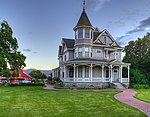Rancho Ex-Mission San Buenaventura
1846 establishments in Alta CaliforniaCalifornia ranchosRanchos of Ventura County, CaliforniaSpanish missions in CaliforniaVentura, California

Rancho Ex-Mission San Buenaventura was a 48,823-acre (197.58 km2) Mexican land grant in present-day Ventura County, California given in 1846 by Governor Pío Pico to José de Arnaz. The grant derives its name from the secularized Mission San Buenaventura, and was called ex-Mission because of a division made of the lands held in the name of the Mission — the church retaining the grounds immediately around, and all of the lands outside of this are called ex-Mission lands. The grant extended east from present day Ventura, excluding the Rancho San Miguel (Olivas) lands, inland up the Santa Clara River to Santa Paula, between the north bank of the River and Sulphur Mountain.
Excerpt from the Wikipedia article Rancho Ex-Mission San Buenaventura (License: CC BY-SA 3.0, Authors, Images).Rancho Ex-Mission San Buenaventura
Wheeler Canyon Road,
Geographical coordinates (GPS) Address Nearby Places Show on map
Geographical coordinates (GPS)
| Latitude | Longitude |
|---|---|
| N 34.36 ° | E -119.15 ° |
Address
Wheeler Canyon Road
Wheeler Canyon Road
California, United States
Open on Google Maps








